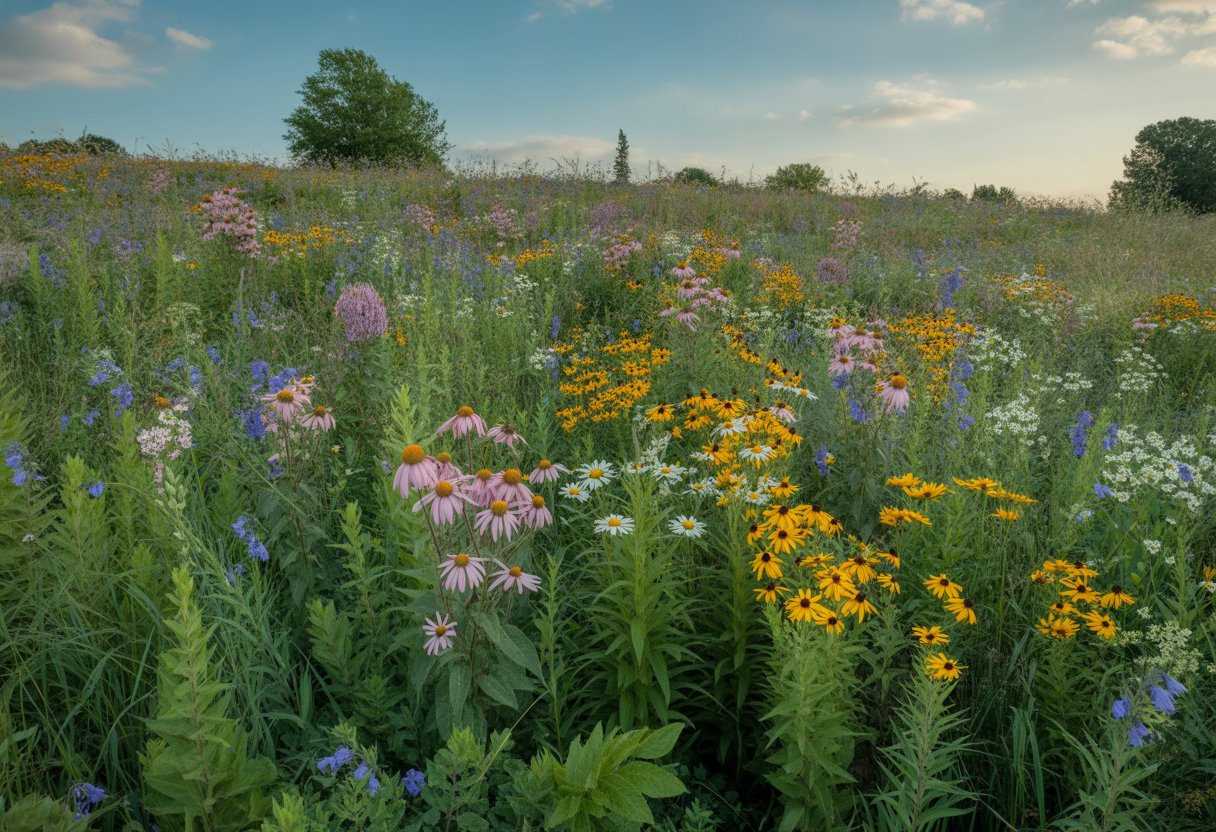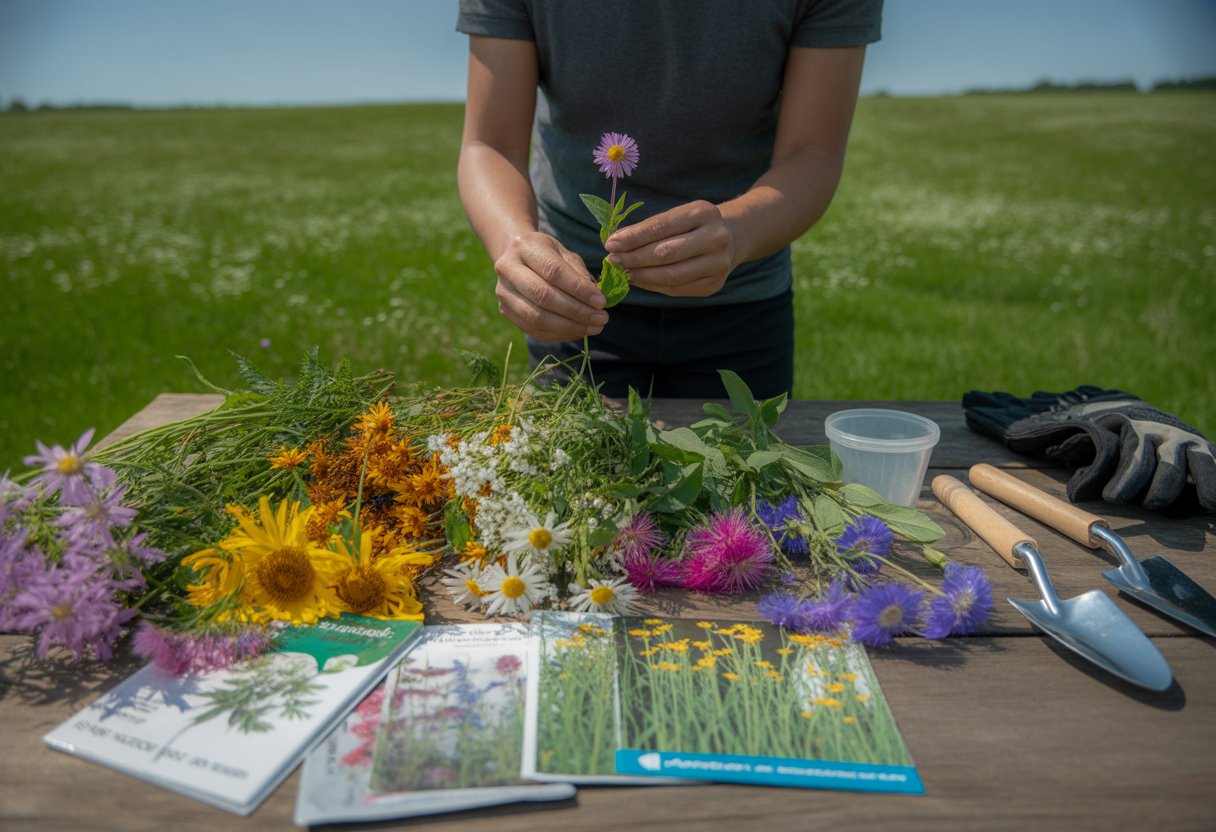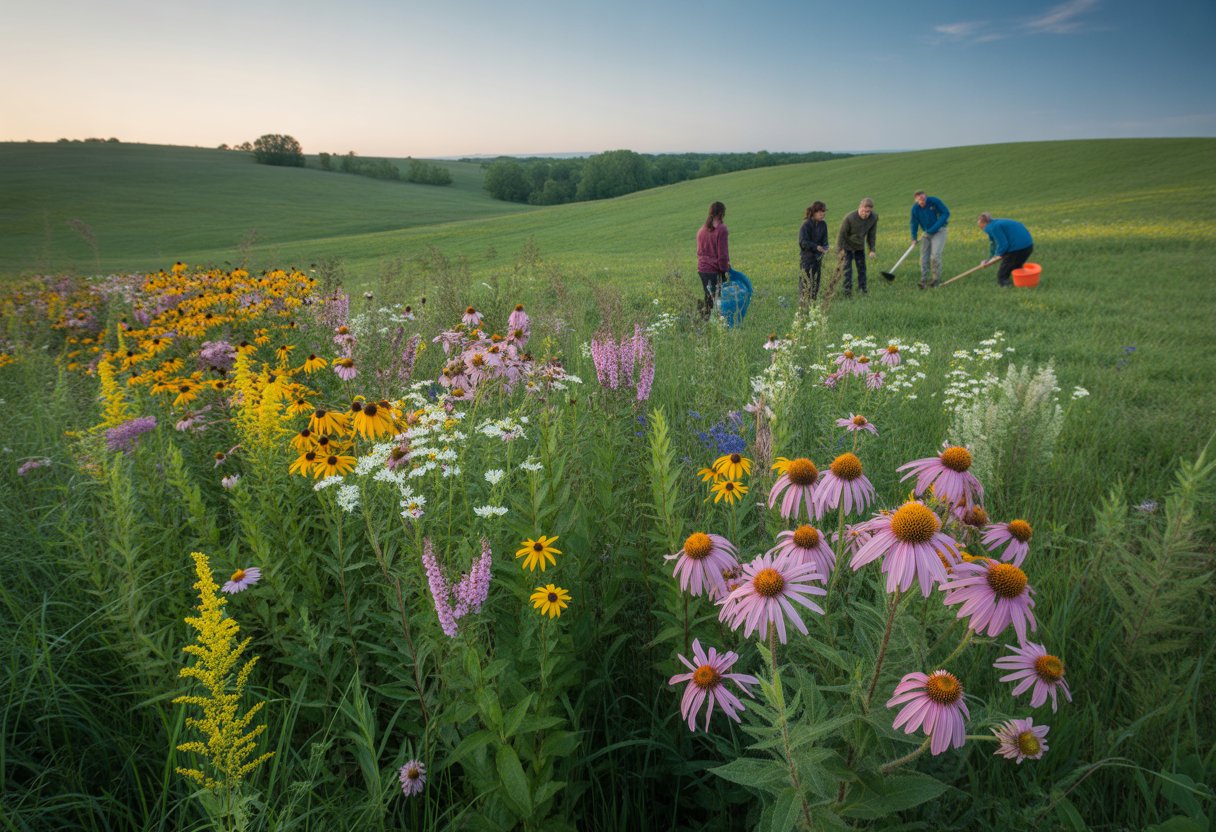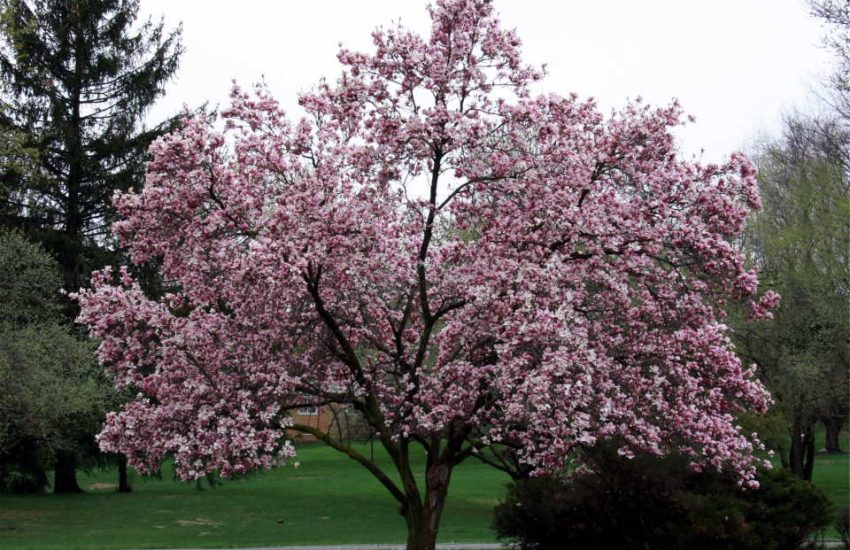Wildflower Meadow Planting Ohio Best Practices for Successful Growth
Planting a wildflower meadow in Ohio means picking native species that can handle the state’s climate and soil. A good mix of perennial wildflowers and grasses suited to Ohio’s USDA hardiness zones keeps your meadow healthy and colorful.
This approach helps local wildlife and usually cuts down on maintenance.

You’ll want to figure out the site’s sunlight, soil type, and drainage before planting anything. Clear the area and, if you think it needs it, enrich the soil to help wildflowers get a solid start.
Timing matters too. Plant in spring or fall for better germination and growth.
A wildflower meadow brings beauty and ecological value to any Ohio yard. It also gives habitat for pollinators and helpful insects, which is a win for biodiversity in cities and rural spots alike.
Planning a Wildflower Meadow in Ohio
If you want your wildflower meadow to thrive, pay attention to location, pick native plants that fit, and prep the soil well. These steps help species like Ohio spiderwort settle in fast and keep maintenance low.
Site Selection and Evaluation
Most wildflowers in Ohio need full sun. Shady spots often lead to weak meadows or just a lot of grass.
Look at your soil—check its texture and fertility. Ohio’s clay soils can work for wildflowers, but sometimes you’ll need to improve drainage or add amendments.
Try to avoid places with lots of foot traffic or tangled tree roots.
Check what’s growing there already. If you see invasive plants, remove them before planting. Bigger plots are actually easier to manage and support more wildflower diversity.
Choosing the Right Seed Mix
Go for a seed mix packed with native plants that fit Ohio’s climate and soils. Add species like Ohio spiderwort for spring color and native grasses for structure.
A solid mix usually has:
- 50-70% wildflowers like black-eyed Susan, wild petunia, and purple coneflower.
- 30-50% native grasses such as little bluestem and switchgrass.
Skip mixes with aggressive non-natives. Buy from Ohio-focused seed suppliers if you can.
Think about bloom times too, so you get flowers all season.
Soil Preparation and Stratification
Start by removing existing plants with tilling or herbicide to get a bare mineral seedbed. This helps seeds connect with soil.
Many Ohio wildflower seeds need cold stratification—cold, moist conditions to wake up. You can mimic this by sowing in late fall or chilling seeds in the fridge before planting.
Test your soil pH. Most wildflowers like it slightly acidic to neutral (pH 6.0-7.0). Don’t overdo the nutrients—over-fertilizing just encourages grasses.
Planting and Establishment Techniques
Timing, seeding rates, and soil moisture management all play a part in helping your wildflower seeds get established.
Optimal Timing for Sowing Wildflower Seeds
In Ohio, sow wildflower seeds in early spring or late fall. Early spring means after the last frost—usually mid-April to early May—so seedlings catch spring rain and warmth.
Fall sowing, from late October through November, gives seeds a natural cold stratification over winter. This helps break dormancy and boosts spring germination.
Fall planting also lets you dodge some weed competition.
Which window you pick depends on your site and seed mix. Some prairie plants like fall sowing better, while others do fine in spring.
Seeding Rate and Methods
Seeding rates depend on your mix. Generally, you’ll want 3 to 5 pounds of seed per acre for a diverse meadow.
Too little seed gives you patchy coverage; too much can crowd out plants.
Broadcast spreading works if you’ve got a clean seedbed, followed by a light rake or rolling. Using a native grass drill gives you even depth and distribution, which can really help germination.
Mix heavier or odd-shaped seeds with sand for even spreading. Don’t bury seeds deep—just a quarter inch of soil cover is plenty.
Watering and Managing Soil Moisture
Keep the top inch of soil moist during germination and early growth. You might need to water daily in warm weather until seedlings show up.
Once wildflowers are established, they can handle dry spells. Still, consistent moisture during the first year makes a difference.
Don’t drown them, though—too much water or poor drainage causes root rot and disease.
A simple soil check with your finger or a tool helps you avoid stressing new plants. Ease off watering once they’re established so roots grow deeper.
Selecting Wildflower Species for Ohio Meadows

Picking the right wildflower species makes your meadow tough and diverse. Focus on native plants that handle Ohio’s climate and soil, and help local wildlife.
Adding grasses and “support” plants improves habitat and keeps the meadow stable.
Essential Native Wildflowers
Ohio’s native wildflowers are built for the region. Purple coneflower (Echinacea purpurea) and black-eyed Susan (Rudbeckia hirta) bring color and survive drought.
You’ll also want goldenrod for late blooms and asters like New England aster to attract fall pollinators.
Penstemon digitalis gives you white spikes and doesn’t need much water. Plains coreopsis adds bright yellow and likes well-drained soils.
These all set up fast and need less care than exotics. They also support Ohio’s native wildlife and keep the landscape feeling authentic.
Attracting Pollinators
Choose wildflowers that help pollinators. Bergamot (Monarda) and liatris spicata draw in butterflies and bees.
Milkweeds like common milkweed and swamp milkweed are must-haves for monarchs—both for nectar and as host plants for caterpillars. Tradescantia ohiensis (Ohio spiderwort) offers early pollen for bees.
Pick a range of bloom times, spring to fall, so pollinators always have something to visit. It’s a simple way to keep pollinator numbers up and support plant reproduction.
Incorporating Native Grasses and Support Species
Grasses help with soil structure, fight erosion, and break up the look of the meadow. Little bluestem and prairie dropseed are solid choices and can handle Ohio’s weather swings.
Support plants like catchfly fill in bare spots and steady the soil. Mixing up plant heights and root depths makes a more layered and resilient meadow.
This combo stands up to drought and keeps invasives in check, making your planting last longer.
Management and Long-Term Success

You’ll need to care for your wildflower meadow to keep it healthy and buzzing with pollinators. Weed control and supporting native biodiversity are key for a balanced meadow.
Seasonal Maintenance Practices
Start maintenance with a late fall or early spring mow. Cutting plants back to 4-6 inches clears out dead growth and stops woody plants from taking over.
Keep an eye on plant health. Skip the fertilizer—too much nitrogen helps grasses, not wildflowers.
Sometimes, controlled burns can help if you’re in a spot where that’s allowed.
After the meadow’s established, watering isn’t usually needed. If there’s a long drought in the first couple years, you might want to water a bit.
Controlling Weeds and Invasive Species
Weeds shape your meadow, for better or worse. Spot invasive plants like garlic mustard and multiflora rose early and pull them out.
If you need to use herbicides, apply them carefully and follow local rules so you don’t hurt your wildflowers. Mow before weeds go to seed to keep them from spreading.
Some weeds—like thistles and smooth bromegrass—can be stubborn and need repeated efforts. Planting a diverse mix helps crowd out unwanted plants, so keep your species diversity up for the best results.
Supporting Biodiversity in Ohio Landscapes
If you want to boost biodiversity, try planting a mix of native wildflowers. Choose species that bloom at different times—this way, pollinators have something to visit all year.
Purple coneflower, black-eyed Susan, and milkweed? Those are some favorites. They’re not just pretty; they really help out local pollinators.
Adding native grasses into the mix gives insects and small wildlife places to hide and live. It just feels more alive, honestly.
Buffer zones with shrubs or trees can make a big difference, especially if you’re near farms or developed spots in Indiana or Illinois. They help connect habitats and make the landscape feel less fragmented.
You could also leave some bare ground patches here and there. Ground-nesting pollinators actually need those open spots.
Take a look at how everything’s doing from time to time. If some plants aren’t thriving, switch things up. That’s how you keep a meadow healthy and resilient, even when things get unpredictable.

